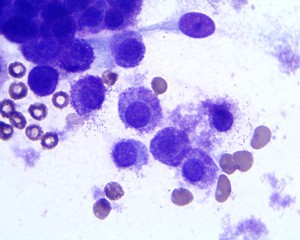What is Cancer?
Cancers are diseases caused by cells which are replicating out of control, forming a population of clones. The “parent” cell is a normal cell in the body. The different kinds of cancer are designated by what kind of cell that parent cell was, such as a bone cell, a skin cell, or a blood cell. This tells us the “family” the cancer belongs to. Often, the cancer is then further categorized by how abnormal the cells appear, or whether they have spread to other parts of the body. This process is called staging. Staging is used to determine the prognosis for that patient, and the relative likelihood of response of the patient to treatment.
Signs of cancer include: unexplained weight loss; chronic vomiting or diarrhea; changes in appetite or thirst; new lumps; changes in the shape of the abdomen or face; a chronic cough; just not “acting right”. While there are also many potential causes of these signs other than cancer, these are all changes that warrant further investigation. The veterinarian will perform a complete physical examination, and further testing may include bloodwork, radiographs or ultrasound. If a suspicious area is identified, then the next step is sampling to determine the type of disease that is present.
How is Cancer Diagnosed in Dogs?
Cancer is diagnosed by looking at suspicious cells to see whether they are abnormal, and what type of cell they are. Veterinarians can sample cells in one of two ways. Cytology is when a needle is used to take a few cells from the area, the cells are placed on a slide, and then the cells are examined under a microscope. This yields a very small sample, but is sufficient for some types of cancer. Histopathology is when a larger sample (like a mass or a piece of a mass) is sent to a specialist for a more in-depth review of the tissues. This test yields a lot more information, but sometimes still further testing is needed on this sample to determine subcategories of disease.
After a cancer diagnosis, your veterinarian will discuss the expected course and treatment options with you. Comprehensive treatments can involve staging of the cancer, surgical removal of the primary tumor, and chemotherapy treatments, as well as addressing pain control, nutrition, and overall health and wellness concerns.





